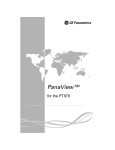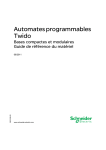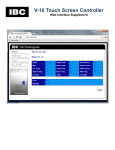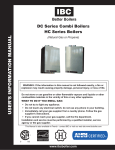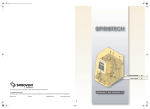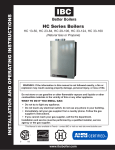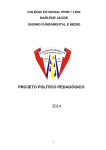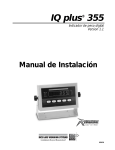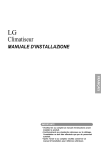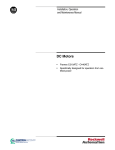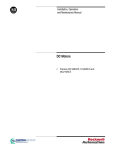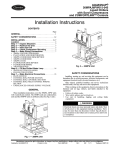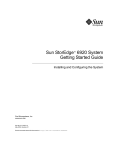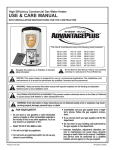Download Installation Manual - IBC Better Boilers
Transcript
IBC IBC Technologies Inc. Vancouver, Canada VFC Modulating Gas Boilers • • • • Model VFC 35-90 (natural gas) Model VFC 50-130 (natural gas) Model VFC 35-100LP (propane) Model VFC 45-130LP (propane) INSTALLATION AND OPERATING INSTRUCTIONS WARNING: If the information in this manual is not followed exactly, a fire or explosion may result causing property damage, personal injury, or loss of life. Do not store or use gasoline or other flammable vapours and liquids or other combustible materials in the vicinity of this or any other appliance. Should overheating occur or the gas supply fail to shut off, do not turn off or disconnect the electrical supply to the pump. Instead shut off the gas supply at a location external to the appliance WHAT TO DO IF YOU SMELL GAS: • • • • • Do not try to light any appliance. Do not touch any electrical switch; do not use any phone in your building. Immediately call your gas supplier from a nearby phone. Follow the gas supplier’s instructions. If you cannot reach your gas supplier, call the fire department. Installation and service must be performed by a qualified installer, service agency or the gas supplier. VFCM-MANv2.0 TABLE OF CONTENTS 2.3 2.3.1 2.3.2 USER INTERFACE........................ 17 Keypad Functions.............................. 17 Indicator Lights ................................. 18 1. INSTALLATION ...................... 3 1.1 GENERAL..........................................3 1.2 CODE REQUIREMENTS ................3 3. STARTUP ..............................19 1.3 Location ..............................................4 3.1 PRIOR TO START-UP .................. 20 1.4 1.4.1 1.4.2 1.4.3 Venting ................................................4 Applications .........................................5 Category IV Venting..........................10 Closet Installations .............................10 3.2 ADJUSTMENT FOR ALTITUDE 20 4. MAINTENANCE AND TROUBLESHOOTING...........21 1.5 Water Piping.....................................10 1.6 Gas Piping.........................................12 1.7 1.7.1 1.7.2 1.7.3 Electrical Connections .....................13 Mains Hook-up ..................................13 Thermostat wiring ..............................14 Thermostat Heat Anticipator..............14 2. BOILER SYSTEMS AND OPERATION................................. 14 2.1 2.1.1 2.1.2 ELECTRONIC CONTROL MODULE..........................................14 Logged Data.......................................14 Glossary of Terms ..............................15 2.2 2.2.1 2.2.2 2.2.3 2.2.4 2.2.5 2.2.6 SEQUENCE OF OPERATION ......15 Standby ..............................................15 Purging...............................................15 Ignition...............................................15 Heating ...............................................16 Circulating..........................................16 Error Mode.........................................16 IBC Technologies Inc. 4.1 4.1.1 4.1.2 BOILER MAINTENANCE............ 21 General Care...................................... 21 Inspection .......................................... 21 4.2 4.2.1 4.2.2 4.2.3 4.2.4 4.2.5 4.2.6 4.2.7 4.2.8 4.2.9 COMPONENT DESCRIPTION.... 22 Fan/Blower........................................ 22 Gas Valve .......................................... 22 Mass Airflow Sensor......................... 22 Oxygen Sensor .................................. 22 Flow Switch ...................................... 22 Hi-Limit............................................. 22 Transformer....................................... 22 Temperature Sensors ......................... 23 Control Module ................................. 23 4.3 4.3.1 4.3.2 TROUBLESHOOTING GUIDE.... 23 Preliminary Checks ........................... 23 Troubleshooting Electronic Components....................................... 24 Troubleshooting With the Control Module .............................................. 25 Detailed System Checks.................... 28 4.3.3 4.3.4 -2- VFC Modulating Boilers 1. INSTALLATION 1.1 GENERAL Table 1 - Connections VFC modulating boilers are low pressure, fully condensing units having a variable inputs ranging from 35 MBH (35,000 Btu/hr) to 130 MBH. The boilers are approved for either Direct Vent (sealed combustion) or Category IV (indoor air) applications, providing a great degree of installation flexibility. The installer must clearly indicate the vent category for the installation on the rating plate using an indelible marker. See section 1.4 - Venting. Figure 1. shows outer case dimensions and piping and electrical holes. Use this diagram to find a suitable location for the boiler. (see also Section 1.3 Location.) 34" [864mm] G 1” NPT B water inlet 1” NPT C gas ½” NPT D electrical power 3/4” E thermostat 3/4” F pump 3/4” G combustion air 4.0" H exhaust vent 4.0" Where required by jurisdiction, installation must conform to the Standard for Controls and Safety Devices for Automatically Fired Boilers, ANSI/ASME CSD-1. If there is any conflict in the above requirements, then the more stringent requirement will apply. FOR YOUR SAFETY Do not store or use gasoline of other flammable vapors and liquids in the vicinity of this or any other appliance. In Canada, installations must conform to the current CAN/CGA B149 and the Canadian Electrical Code Part 1 CSA C22.2 No. 1. H Figure 1. Dimensions/Connections IBC Technologies Inc. water outlet Installation must conform to local codes, or in the absence of these, with the latest editions of the National Fuel Gas Code ANSI Z223.1 and the National Electrical Code ANSI/NFPA 70. 22.5" [572mm] 12" [305mm] A Gas manifold and controls met safe lighting and other performance criteria when boiler underwent tests specified in ANSI Z21.13-2000 / CSA 4.9-2000. A Instructions to put the boiler in operation are located on the inside surface of this cover panel. Size 1.2 CODE REQUIREMENTS 12" [305mm] 22.5" [572mm] Description -3- VFC Modulating Boilers • 1.3 Location Keep boiler area free and clear of combustible materials, gasoline, and other flammable vapours and liquids. • • • VFC-series boilers are designed and approved for wall or floor installation (on combustible flooring), with significant flexibility of location provided with the available venting options. The boiler can be placed in an alcove, basement, closet or utility room. • Care must be taken not install the boiler in areas where the combustion air source is subject to chemical fouling. Experience has shown that exposure to corrosive chemical fumes such as chlorinated and/or fluorinated hydrocarbons can reduce the life of a boiler. Cleaners, bleaches, air fresheners, refrigerants, aerosol propellants, drycleaning fluids, de-greasers and paintremovers all contain vapours which can form corrosive acid compounds when burned in a gas flame. Airborne chorides such as those released with the use of laundry detergents are also to be avoided. For this reason, the Category IV (indoor air) venting option using air surrounding the boiler should not be used in a laundry room installation. Table 2 - Clearance from Boiler Cabinet Surface Front Rear L. Side R. Side Top Distance from Combustible Surfaces 2” 0” 0” 2” 10” Recommended Distance for Service 24” 0” 12” 18” 10” Below the boiler, 12” is required to provide clearance for the inlet and exhaust venting together with the required condensation trap. Legs are available as an accessory for floormounting of the boiler; the 14” legs provide the necessary clearance. It is recommended that the boiler be located in an area where water leakage will not result in damage to the area. If a location such as this cannot be found, a suitable drain pan, should be installed under the appliance. The boiler is not to be installed above carpeting. 1.4 Venting In addition to the foregoing, other factors determining potential mounting sites: IBC Technologies Inc. ensure minimum clearance requirements for combustible materials(see Table 2) are satisfied 36” clearance at the front is recommended for adequate servicing gas ignition system components should be protected from water (dripping, spraying, rain, etc.) boiler should not be exposed to water leaks from piping or components located overhead in a new construction installation, particular action must be taken to protect the boiler from dust; combustion air should be drawn from a CLEAN source (e.g. outdoors) and the boiler should be isolated from interior dust sources. Do not seal boiler case openings directly - allow for air circulation and ventilation in the immediate area. All venting must be installed in accordance with the requirements of the -4- VFC Modulating Boilers any exhaust fans, such as range hoods and bathroom exhausts, so they will operate at maximum speed. Do not operate a summer exhaust fan. Close fireplace dampers. jurisdiction having authority: in the USA Part 7, Venting of Equipment of the National Fuel Gas Code, ANSI 223.1, latest edition, and any other local building codes are to be followed. In Canada, Part 7 - Venting Systems of the B149 Code prevails. Where there is a discrepancy between the installation instructions below, and the code requirements, the more stringent shall apply. d. Place in operation the appliance being inspected. Follow the lighting instructions. Adjust thermostat so appliance will operate continuously. e. After it has been determined that each appliance remaining connected to the common venting system properly vents when tested as outlined above, return doors, windows, exhaust fans, fireplace dampers and any other gas-burning appliance to their previous conditions of use. IMPORTANT When an existing boiler is removed from a common venting system, the common venting system is likely to be too large for proper venting of the appliances remaining connected to it. At the time of removal of an existing boiler the following steps shall be followed with each appliance remaining connected to the common venting system placed in operation, while the other appliances remaining connected to the common venting system are not in operation. f. Any improper operation of the common venting system should be corrected so the installation conforms with the National Fuel Gas Code, ANSI Z223.1 - latest edition. In Canada, all installations must conform with the current CAN/CGA - B149 Installation Code and/or local codes. a. seal any unused opening in the common venting system. When resizing any portion fo the common venting system, the common venting system should be resized to approach the minimum size as determined using the appropriate tables in the National Fuel Gas Code, ANSI Z223.1 - latest edition. In Canada, use the CAN/CGA - B149 Installation Code. b. Visually inspect the venting system for proper size and horizontal pitch and determine there is no blockage or restriction, leakage, corrosion and other deficiencies which could cause an unsafe condition. c. Insofar as is practical, close all building doors and windows and all doors between the space in which the appliances remaining connected to the common venting system are located and other spaces of the building. Turn on clothes dryers and any appliance not connected to the common venting system. Turn on IBC Technologies Inc. 1.4.1 Applications All VFC-series boilers are approved with alternative venting options: either Direct Vent or Category IV venting can be used offering flexibility to meet the specific requirements of the installation. With the Direct Vent case, combustion air is piped directly to the boiler’s air -5- VFC Modulating Boilers Exhaust venting is to be connected directly to the 2” NPT male threaded stainless steel fitting on the bottom of the pressure vessel using a 2" CPVC NPT x Socket fitting (female threaded adaptor or 90° elbow). A condensate trap of CPVC and PVC shall be spliced into the CPVC exhaust pipe at or near the base of the boiler (see Figure 2). intake from outdoors. Using the Category IV alternative, air for combustion is drawn from the indoor air surrounding the boiler or drawn from ventilated attic or crawl spaces. The standard VFC boiler is shipped with a high water temperature limit switch set for 200°F. Provided the maximum overall vent length limit is not exceeded, the installer may choose to vent the boiler through the wall, directly through the roof or upward using an existing - but otherwise unused - chimney as a vent raceway (see below). Combustion air piping is connected at the base of the boiler using a standard 2" PVC coupler or elbow. Screen material shall be placed at the inlet as appropriate for the environment (e.g. insects, dust). 1.4.1.2 Vent Travel Using the standard 2” piping, the boiler can be sited up to 60 equivalent feet from the vent termination. The actual vent travel is reduced for fittings in accordance with Table 3. - for example, using 5 x 90º ABS long-sweep* elbows, the maximum lineal measure is 35 feet. Direct vent installations requiring longer travel can be satisfied using 2½” or 3" intake and vent piping (the latter subject to an initial 10’ of 2” CPVC - which is included in the limit for 2½” or 3" pipe). All boilers are shipped with connectors permitting attachment of 2” intake piping. It is a code requirement that the rating plate reflect the nature of the boiler vent configuration as installed. To facilitate such venting installation flexibility, VFC boilers are shipped with the rating plate unmarked. The installer shall indelibly mark the appropriate box on the rating plate to recognize the venting alternative chosen. Table 3 - Max. Venting Length 1.4.1.1 Intake/Exhaust Vent Material Pipe Size 2” 2½” or 3" 90° elbow(CPVC/PVC) 45° elbow(CPVC/PVC) 90° elbow*(ABS) 45° elbow*(ABS) The approved materials of construction: For the exhaust vent• 2" CPVC Sch. 40 or 80 pipe (per ASTM F441) and Sch. 40 or 80 fittings for the initial 10 lineal feet of travel • 2", 2½" or 3" Sch 40 CPVC or PVC(ASTM D1785 or D2665); alternatively: 2" or 3" ABS (Sch. 40/ASTM D2661 or F628) and fittings thereafter; If the 2½” or 3" piping alternative is selected, a 3"x2" (or 2½” x 2” as appropriate) bushing is to be used in the inlet piping within 3 feet of the combustion air line clearance hole at the base of the boiler. Such 3’ interval (which is part of the 90’ max. travel For the inlet air - 2", 2½" or 3" PVC or 2" and 3" ABS are permitted. IBC Technologies Inc. Max. Equiv.Length 60’ 90’ allow 8’ equiv. allow 4’ equiv. allow 5’ equiv. allow 2.5’ equiv. -6- VFC Modulating Boilers elbows and threaded union fittings. The trap must be installed as follows: • Must be 5”min in height (see Fig. 2.) • Must be piped to within 3” of a drain or be connected to a condensate pump (using ½" PVC) • Drainage line must slope down to the drain at a pitch of ¼” per foot so condensate runs towards the trap • IMPORTANT! Fill trap with water before boiler is first fired to prevent exhaust fumes from entering room. Never operate the boiler unless the trap is filled with water. • Trap should be checked every 6 months. Clean and refill as necessary. distance) is allowed to provide space for splicing in the optional 2” compatible air filter unit. On the exhaust side, a 3" x 2" (or 2½”- 2”) reducer must be placed in a vertical section of the flue gas vent, to avoid pooling of condensate. Exhaust venting must slope down to the trap/drain with a pitch of at least ¼” per foot so condensate runs towards the trap. Support should be provided every 2 to 3 feet for each of the intake and vent piping. Insulate exhaust piping where it passes through unheated space with appropriate pipe insulation to prevent freezing of condensates. Ensure all venting components are clean of burrs/debris prior to assembly. Care is to be taken to avoid ingestion into the fan of CPVC/ABS/ PVC debris left in the combustion air piping. All joints must be secured using CPVC, PVC, or ABS/PVC solvent cement to bond the respective pipe material. Use solvent cement on the connector located at the CPVC/ABS or PVC junction (e.g. 10’ along the exhaust piping). Follow the cement manufacturer’s instructions closely when joining various components. All vent connections must be liquid and pressure tight. Test exhaust venting connections, under fan pressure with vent blocked, using a soap/water solution prior to firing. ¼" vertical per horizontal foot 1.4.1.3 Condensate Trap A condensate trap must be installed at the base of the boiler (or within 12” of the first 90° exhaust line elbow), as shown in Figures 2. (e.g. spliced into the 2” PVC exhaust vent using a straight 2" tee or a 2” x ½” x 2” reducing tee). The trap itself is formed using ½” PVC pipe for the drop leg, with ½” PVC pipe, IBC Technologies Inc. fill with water 5" min. to drain or condensate trap Figure 2. Condensate Trap Alternatives -7- VFC Modulating Boilers 1.4.1.4 Venting Passage Through Ceiling and Floor 12" min. The following instructions apply to 2”, 2½” and 3" piping: • pipe clearances - no specific requirements; follow local codes • piping must be supported in the flooring • all piping must be liquid and pressure tight. 36" min. snow line 12" min. 2" min. other than as listed, vents terminate in the sam e manner as in figure 3. above. Figure 4. Vent Terminations Through a Flat Roof 1.4.1.5 Rooftop Vent Termination Vents must terminate as follows: • 12” above grade and normal snow line to vent terminal bottom • DO NOT exhaust vent into a common venting system (See Figures 3 & 4 for rooftop vent terminations) • • exhaust vent with screen • air intake 180° elbow with screen face down 10 ft. or less 2 ft. min. 12"min. • 12" min. 2" min. snow line 24" min. 2" min. • Figure 3. Vent Terminations through a Pitched Roof 1.4.1.6 Sidewall Vent Termination Vents must terminate as follows: minimum 12” from any building opening minimum 3’ above any forced air intake located within 10’ minimum 4’ horizontally from (and in no case above or below) unless 4’ horizontal distance is maintained, from electric or gas meters, regulators and relief equipment not to be located over public walkway, in a confined space, or under any overhang or deck vents must be installed such that flue gas does not discharge towards neighbor’s windows, or where personal injury or property damage can occur. for Direct Vent installations employing sidewall vent terminations, both the inlet and exhaust terminations shall be located on the same plane (side) of the building, with the exhaust outlet placed above the inlet to avoid reingestion. (See Figures 5,6, & 7 for side wall vent terminations) IBC Technologies Inc. -8- VFC Modulating Boilers MIN. 24" TO ANY OVERHANG MIN. 12" TO ANY OPENING MIN. 4’ HORIZONTAL DISTANCE FROM ANY GAS OR ELECTRICAL MIN 36" TO METER INTAKE MIN. 12" SNOW LINE Figure 5. Side Wall Venting installation below average snow level vent tee should be parallel to side wall. intake should be swung to parallel 4−3/8" with side wall. minimum min. 12" between bottom of intake and bottom of vent 12" min. clearance to any overhang FIELD SUPPLIED PLASTIC STRAPPING MUST BE USED TO SECURE THE VENT TO THE STRUCTURE 5−1/2" 24−1/2" 18−1/2" 12" 12" min. above average snow level Figure 6. Side Wall Vent Terminations (Configuration 1) 2" or 3" ABS or 2", 2.5" or 3" PVC 4x 3" or 4x2½" reducing bushings as required 2" or 3" ABS or 2", 2.5" or 3" CPVC or PVC 3"x3"x2" ABS or PVC Tee (alt: 4x4x3 Tee) If 3" venting is used, the exhaust line must be reduced to 2½" immediately prior to entering the 4" termination tee to allow adequate intake clearance. Use a 3 x 2½" reducer and 4x2½ bushing Figure 7. Side Wall Vent Terminations (Configuration 2) IBC Technologies Inc. -9- VFC Modulating Boilers Indoor combustion air must not expose the boiler to contamination - see Section 1.3 - Location, above. In other respects, Category IV venting is installed in the same manner as for the exhaust side of Direct Vent installations, except that there is no 2½” extended travel vent option in the Category IV configuration. 1.4.2 Category IV Venting A category IV venting system is one in which air for combustion is take from the ambient air around the boiler. Vent piping is run horizontally or vertically to the outdoors. 1.4.2.1 Ventilation and Air Supply To support combustion, an ample air supply is required. This may require direct openings in the boiler room to the outside. If the boiler is not in a room adjacent to an outside wall, air may be ducted from outside wall openings. Provisions for combustion and ventilation air must be made as follows: in the USA, in accordance with Section 5.3 Air for Combustion and Ventilation of the National Fuel Gas Code, ANSI Z223.1 (latest edition), or applicable provisions of the local building codes; in Canada, in compliance with CAN 1.4.3. 1.4.3 Closet Installations The following lists are recommendations for buildings of energy-saving construction, fully caulked and weatherstripped: Follow applicable Codes and good piping practice. Any uninsulated hot water pipes must be installed with a minimum 1” clearance from combustible materials. • • • • For installations in a confined space (such as a closet), ventilation openings must be provided through a door or wall to prevent excessive heat from building up inside the space. Minimum requirements: • one opening within 12” of the ceiling (100 sq. in. opening) • one opening within 12” of the floor (100 sq. in. opening) 1.5 Water Piping an opening to the outside, within 18” of the floor, but no less than 6” off the floor, should be provided in the room. Each opening should be covered in a grill, and have an area of 1” per 1,000 BTUh for ALL APPLIANCES in the area. Openings must not be closed or reduced. Doors and windows used for air supply must be locked open. Mechanical draft exhaust or supply fans are not to be used in or near the boiler area Boiler combustion and ventilation airflow must not be obstructed IBC Technologies Inc. System piping is connected to the boiler using the 1” NPT female threaded fittings provided at the locations shown on page 10. Typical piping systems are shown in Figures 8, 9, &10. A 30 psi pressure relief valve (¾” NPT) is supplied for field installation in the flow supply line, in the manner shown in Figures 8, 9, & 10. Relief valve discharge piping must terminate 6” above a drain using plain un-threaded end, or per local Code. To avoid water damage, system piping and components are not to be located overhead the boiler. - 10 - VFC Modulating Boilers hydronic flow check(s) o zone valves to prevent thermal circulation air vent contractor supplied system circulator(s) 12−18" system supply piping air purger diaphragm expansion tank stop & waste or ball valve #30 #15 system return piping auto fill valve 12 psi min. backflow preventer boiler feedwater tee & boiler drain for system purging pressure relief valve ball valve Figure 8. Sample Piping Schematic (1) cold supply flow check drain system supply system return piping aquastat flow check hot cold pressure relief valve indirect domestic water heater T&P relief Figure 9. Sample Piping Schematic (2) note: wire aquastat or control contacts in series wit parallel wired zone control end switches or pump relay contacts. air eliminator (additional zones) wire to zone valve end switches or relay contacts zones diaphragm expansion tank buffer/tempering tank pressure relief valve Figure 10. Sample Piping Schematic (3) IBC Technologies Inc. - 11 - VFC Modulating Boilers calibrated to close with at 4.5 US gpm and open at 4.0 US gpm. The VFC boiler is designed for supply water temperatures within the range 80°F to 180°F, with a 20°F rise. Water flow rates and pressure drop (head in ft. w.c.) associated with a 20°F maximum rise (∆°T) for the respective VFC models are as follows: When installed in a low mass heating system such as an in-floor radiant application, the VFC-series boilers may benefit through use of a buffer tank to ensure a controlled supply temperature, and to prevent short cycling. It is highly recommended that a buffer tank be included in any heating system in which any single zone has radiative loading lower than 1/3rd of the minimum input of the boiler (i.e. at 35,000 BTU/hr, the boiler should be buffered if any single zone attached is below 12,000 Btu/hr). Table 4 - Flow Rate Model Flow (USgpm) Approx. Head (ft. wc) VFC 35-90 9.0 5 VFC 50-130 13.0 10 VFC 35-100LP 10.0 6.5 VFC 45-130LP 13.0 10 Propylene glycol solution is commonly used in a water heating loop where freeze protection is required. Its density is lower than that of water, resulting in lower thermal performance at a given flow and pressure. As a rule of thumb, a 50%:50% solution of propylene glycol and water will require an increased system circulation rate (gpm up 10%), and system head (up 20%) to provide performance equivalent to straight water. Water flow rates must not be allowed to fall below 6 gpm (35-90 & 35-100LP series: 5 gpm) in any possible operating condition (eg. single zone in use). To achieve system flow rates and temperatures within such limits, care must be taken to select the appropriate pump. Evaluate pressure drop across the system, including the above head values for the boiler itself. Ensure pump is rated for the design circulating water temperatures; some pumps have a minimum water temperature rating above the low temperature potential of the boiler. Following installation, confirm actual performance by measuring ∆°T (under high and low flow conditions) after establishing the correct firing rate (see Section 2.2 – Check Boiler Input). Whether required by local Codes or otherwise, it is recommended that piping systems include a suitable check valve, gate valve and feedwater regulator set at 12 psig. in the make-up water link with the city main. Use of unions and gate or ball valves at the boilers supply and return water connections is recommended to simplify servicing. 1.6 Gas Piping The boiler requires an inlet gas pressure of at least 4.0” w.c. for natural gas and 10.5" w.c. for propane. For either fuel, the inlet pressure shall be no greater than 14.0” w.c. Confirm this pressure range is available with your local gas supplier. VFC-series boilers are supplied with a integral low-water flow switch, which allows installation of the boiler above radiation level. The flow switch is IBC Technologies Inc. - 12 - VFC Modulating Boilers The inlet gas connection of the boiler’s gas valve is 1/2” NPT (female). The boiler and its gas piping shall be leak tested before being placed into operation. Adequate gas supply piping shall be provided with no smaller than 1/2” Iron Pipe Size (IPS), in accordance with the following chart: The gas valve is provided with pressure taps to measure gas pressure upstream (supply pressure) and downstream (manifold pressure) of the gas valve. Note that manifold pressures vary in accordance with firing rate with the modulating series boilers. Table 5 - Max. Pipe Length (ft) Model 1/2” IPS 3/4” IPS 1” IPS VFC 35-90 20 100 350 VFC 50-130 10 50 175 VFC 35-100LP 50 200 600 VFC 45-130LP 30 125 400 Table 6 - Manifold Pressures Gas piping must have a sediment trap ahead of the boiler’s gas valve (see Figure 11.). A manual shutoff valve must be located outside the boiler, in accordance with local codes/standards. All threaded joints in gas piping should be made with a piping compound resistant to the action of natural gas - do not use Teflon tape. Use proper hangers to support gas supply piping. Natural Gas Units 0.5" - 3.5" w.c. Propane Units 1.2" - 10.0" w.c. All Electrical wiring to the boiler (including grounding) must conform to local electrical codes and/or National Electrical Code, ANS/NFPA No. 70 – latest edition, or The Canadian Electrical Code, C22.1 - Part 1. 1.7.1 Mains Hook-up Line-voltage wiring is done within the field-wiring box. Referring to Wiring Diagram on page 32, connect the boiler to the mains power using a separate, fused circuit and a disconnect means within sight of the boiler. Use 14-gauge conductors in BX cable or conduit appropriately anchored to the boiler case for both mains supply and pump circuits. The transformer primary (black wire) is connected to the neutral and line (hot) wires. The red conductors for the pump contacts should be wired into the ungrounded leg of the pump circuit. full size sediment trap gas valve inside Figure 11. Typical Gas Piping The boiler must be disconnected or otherwise isolated from the gas supply during any pressure testing of the system at test pressures in excess of 1/2 psig. Dissipate test pressure prior to reconnecting. IBC Technologies Inc. Range 1.7 Electrical Connections install manual main shutoff valve 5 ft. above floor when required by local code union Model / Fuel Type Note: The combined current of all pumps connected through the on-board pump relay (red conductors) should not exceed 10 amps. - 13 - VFC Modulating Boilers 1.7.2 Thermostat wiring 1.7.3 Thermostat Heat Anticipator When installed in a non-zoned system, the heat anticipator setting is dependant on the gas valve installed in the boiler: The Thermostat terminal block is located on the control module. The thermostat terminals should NOT be connected to any other power source and should only be connected to a room thermostat, isolated, zone valve end switches or circulator end switches. When using 3wire zone valves (non-isolated) the zone valve end contacts must be isolated from the thermostat terminals using an appropriate relay. Gas Valve Anticipator Current Setting White-Rodgers 36E27 0.5A For zoned systems, each room thermostat’s heat anticipator should be adjusted to the current draw of its associated zone valve. 2. Boiler Systems and Operation 2.1 ELECTRONIC CONTROL MODULE The electronic control module governs ignition and flame safeguards, throttle management, and mixture and temperature control. Additionally, it provides a user interface, and performs data and error logging functions. 2.1.1 Logged Data All data is permanently logged in the controller, and cannot be altered except on replacement of the controller. Ignition Counter The control module tracks the number of successful ignitions in its lifetime. Data may be downloaded at any time from the controller by connecting the optional IBC communications cable between the optical link and a microcomputer. Data includes the following: • Ignition counter • Average water temperature • Average output • Gas usage meter • Error log Average Water Temperature The control module tracks the water temperature averaged over the lifetime of the boiler. Average Output The control module tracks boiler output averaged over the lifetime of the boiler. Gas Usage Meter The control module tracks the amount of gas used in its lifetime. Further information about the communications interface can be found in the user manual for that product. Error Log IBC Technologies Inc. - 14 - VFC Modulating Boilers The error log contains the last 3 errors detected by the controller. 2.2.1 Standby Waiting for a boiler operating signal. The boiler is off during this time. 2.1.2 Glossary of Terms This glossary briefly defines some terms used in the control module functions. 2.2.2 Purging Prepurge On a boiler operating signal, the boiler automatically enters a prepurge cycle. Call for Heat The thermostat indicates that room temperature is below the thermostat setting. A Call for Heat AND a Heat Required signal are needed to start the boiler, and are defined as Heating Enabled. The fan starts and automatically adjusts to a level suitable for ignition. Twenty seconds later, the pump starts. After a total of 30 seconds, the ignition cycle begins. Interpurge Heat Required Temperature sensors on the boiler indicate that water temperature is below the water temperature setpoint. A Call for Heat AND a Heat Required signal are needed to start the boiler, and are defined as Heating Enabled. The boiler enters an interpurge cycle if ignition is unsuccessful. The fan and pump continue to run, and ignition is delayed by an additional 25 seconds. Postpurge The fan remains on for 10 seconds and then reduces airflow to an ultra low flow mode for 90 minutes unless pre-empted. Heating Enabled The boiler is powered and there is a Call for Heat and Heat is Required. (If the boiler is in an error mode, the boiler will not start.) The pump remains on for 5 minutes after the heating cycle ends. If the heating cycle ends as a result of water temperature exceeding setpoint by 8°F, the postpurge will continue as normal, but the boiler will enter the circulating mode. 2.2 SEQUENCE OF OPERATION The control module has 5 cycles during normal operation, as well as an error mode for problem detection: 1. Standby cycle 2. Purging 3. Ignition cycle 4. Heating cycle 5. Circulating cycle 6. Error mode If there is a boiler operating signal any time during this cycle, the postpurge ends, and a prepurge begins, otherwise the boiler will enter standby mode. 2.2.3 Ignition After the prepurge, the gas valve opens for 5.5 seconds. Each state is explained below. A flow chart for the sequence of operation can be found in the back of the manual. IBC Technologies Inc. For the first 3 seconds a spark is delivered to the burner. For the remaining 2.5 seconds, the probe is in a flame sensing mode, and the gas valve is kept open. - 15 - VFC Modulating Boilers minute error cycle. Following the interpurge, the fan and pump are stopped until the end of the error cycle. Normal operation then resumes. Hard Errors result when a condition exists that may be a safety hazard. The boiler enters an extended prepurge then the fan and pump are stopped. The boiler is in a lockout, and must be checked and restarted by a service technician. If no flame is detected at the end of the trial, the interpurge cycle is repeated. If ignition fails 3 times successively, the boiler locks out and must be reset by shutting the main power switch off and back on. A qualified technician should be consulted to establish and remedy. If ignition is successful, the output of the boiler decreases immediately to minimum, and the heating cycle begins. 2.2.4 Heating The heating cycle lasts until the boiler operating signal ends, or until water temperature exceeds the setpoint temperature by 8°F at minimum output. At the end of the heating cycle, the boiler enters a postpurge. A soft error can be identified when the error light and the boiler operating light are on at the same time. If the boiler operating light is not on while the error light is on, the boiler is in a hard error. During the heating cycle, boiler output changes to meet heating demands. Water temperature is regulated about the setpoint to ±3°F. Table 7 lists the hard and soft errors and their causes. Note that other problems such as disconnected wires or defective sensors may be the cause of the error. Always check connections and wiring first. 2.2.5 - Circulating This cycle operates when water temperature exceeds setpoint by 8°F at minimum output, and call for heat is still present. After entering a postpurge, the pump remains on until water temperature is 8°F below setpoint temperature or the boiler operating light is off has ended. Section 3.6.3 - Troubleshooting With the Control Module provides a detailed troubleshooting list for each error condition. 2.2.6 - Error Mode The controller continually checks sensors to see that they are operating within normal parameters. If sensors indicate the boiler is operating outside it limits, it will declare an error condition. 2 types of error conditions can occur: Soft Errors result when an abnormal condition exists which does not present an immediate safety hazard. The boiler enters an extended interpurge and a 5 IBC Technologies Inc. - 16 - VFC Modulating Boilers Hard Errors Hi Limit Table 7 - Soft and Hard Errors Soft Errors Temp.Probe Error • • Low Air • • • Description measured temp exceeds max. input temp. or less than min. input temp. temp. sensor defective or disconnected airflow is below blocked vent threshold. Defective or disconnected mass flow sensor Defective or disconnected fan • Description water temp. has exceeded limit of water temp. switch. Max. Ignition Trials • boiler has failed 3 successive ignition trials Vent Hi-Limit • vent temperature has exceeded limit of vent temp. switch. 2.3 USER INTERFACE 2.3.1 Keypad Functions The keypad allows the user to change the setpoint or operating mode of the boiler. Low Flow • low water flow and vent limit not exceeded The boiler defaults to its normal operating mode during power-up. To change the setpoint temperature, press and hold the key in the desired direction until the setpoint is reached. The most recent setpoint is retained in the controller even if power is interrupted. IBC Technologies Inc. - 17 - VFC Modulating Boilers 2.3.2 Indicator Lights Table 8 - Status Indicators Flashing: Boiler is waiting for a call for heat. Off: Boiler is firing or preparing to fire.* On: Thermostat indicates more heat is needed. Off: Call for heat has ended. On: Boiler is in any mode except standby, or a soft error exists. Off: Boiler is in standby or lockout. On: The error indicator lights when a hard or soft error exists (See section 2.2.6 Errors) In most cases, one of the 4 indicators below will also be flashing when an error exists. On: Boiler is on and temp. sensors are functioning normally. Figure 12. Display The numeric display labeled temperature indicates the current water temperature in °F or °C(toggle between units by pressing and holding both keys simultaneously). Pressing either button individually displays the setpoint temperature. The left-hand column labeled heat provides an illuminated display of the output level of the boiler. The indicators light up sequentially from bottom to top as output increases. The 8 indicators in the right-hand column labeled status display various conditions of the boiler. These indicators are described in Table 8 Status Indicators. On: Pump is running. Flashing: pump is on but no water flow detected On: Fan is on. Flashing: fan is moving less air than normal On: Boiler heating. Flashing: gas valve is open but no flame detected *Provided there is power to the unit. IBC Technologies Inc. - 18 - VFC Modulating Boilers 3. STARTUP FOR YOUR SAFETY READ BEFORE OPERATING WARNING: If you do not follow these instructions exactly, a fire or explosion may result causing property damage, personal injury or loss of life. A. This appliance does not have a pilot. It is equipped with an ignition device which automatically lights the burner. Do not try to light the burner by hand. B. BEFORE OPERATING smell all around the appliance area for gas. Be sure to smell next to the floor because some gas is heavier than air and will settle on the floor. WHAT TO DO IF YOU SMELL GAS • • • Do not try to light any appliance. Do not touch any electric switch; do not use any phone in your building. • If you cannot reach your gas supplier, call the fire department. C. Use only your hand to turn the gas control knob. Never use tools. If the knob will not turn by hand, don’t try to repair it, call a qualified service technician. Force or attempted repair may result in a fire or explosion. D. Do not use this appliance if any part has been under water. Immediately call a qualified service technician to inspect the appliance and to replace any part of the control system and any gas control which has been under water. Immediately call your gas supplier from a neighbor’s phone. Follow the gas suppliers instructions. OPERATING INSTRUCTIONS 1. STOP! Read the safety information above on this label. 5. Remove front cover from appliance. 2. Set the thermostat to lowest setting. 6. Turn gas control knob clockwise ¬ to Off. 3. Turn off all electric power to the appliance by selecting main power switch to Off. 7. Wait five (5) minutes to clear out any gas. Then smell for gas, including near the floor. If you smell gas, STOP! Follow B in the safety information above on this label. If you don’t smell gas, go to the next step. 4. This appliance is equipped with an ignition device which automatically lights the burner. Do not try to light the burner by hand. 8. Turn gas control knob counterclockwise « to On. 9. Replace front cover on appliance. 10. Turn on electric power to appliance by selecting main power switch to On. 11. Set thermostat to desired setting. 12. If the appliance will not operate, follow the instructions “To Turn Off Gas To Appliance” and call your service technician or gas supplier. TO TURN OFF GAS TO APPLIANCE 1. Set the thermostat to lowest setting. 2. Turn of all electric power to the appliance by selecting main power switch to Off. 3. Remove front cover from appliance. 4. Turn gas control knob clockwise ¬ to Off. 5. Replace front cover on appliance Also ensure items under the following caption 3.1 Prior to Start-up have been addressed. IBC Technologies Inc. - 19 - VFC Modulating Boilers 3.1 PRIOR TO START-UP and water temperature setpoint to its minimum setting. Allow the boiler to reach a steady state, then check the boiler input using the following formula: Ensure venting system is complete and seal tested. Confirm any common venting system at the installation site is isolated and independent of the VFC boiler and that any holes left from removal of a previous boiler have been sealed. Fill condensation trap to full 5” (min) neck height. Check water piping system is fully charged, and that all air has been discharged through loosened bleed caps. Use a minimum water pressure of 12 psig. Perform a final check of electrical wiring. Boiler Input Formula 3600 × HV(BTU/ft.) = INPUT time 3.1.1 Test Ignition System Safety Shutoff Device With the boiler in operation, test the ignition system safety shutoff device by shutting the manual gas valve immediately outside the boiler case. Ensure boiler has shut off and error and gas valve lights are flashing. To restart boiler, reset power. time = seconds for 1 cu. ft. of gas through meter HV = heating value of gas as provided by gas supplier INPUT= gas input(in BTU/hr) 3.2 ADJUSTMENT FOR ALTITUDE VFC Modulating Boilers are factory assembled to operate with natural gas at sea level. As altitude increases, the orifice plate between the gas valve elbow and the mixing tube (see Figure 13. Gas Assembly) must be changed as described in Table 9 - Orifice Plate Sizing. O rific e P late To ensure the correct orifice is in place, adjust the thermostat to maximum setting, Figure 13. Gas Assembly Table 9 - Orifice Plate Identification / Sizing (in 0.001" following "D") Model / Altitude 0 - 1,500' 1,501 - 3,000' 3,001 - 4,500' VFC 35-90 M-A005-090SL-D208 M-A005-090A1-D212 M-A005-090A2-D215 VFC 50-130 M-A006-130SL-D250 M-A006-130A1-D255 M-A006-130A2-D259 VFC 35-100LP M-A009-100SL-D139 M-A009-100A1-D142 M-A009-100A2-D144 VFC 45-130LP M-A008-130SL-D159 M-A008-130A1-D162 M-A008-130A2-D164 IBC Technologies Inc. - 20 - VFC Modulating Boilers 4. MAINTENANCE AND TROUBLESHOOTING 4.1 BOILER MAINTENANCE The owner is responsible for general care of the boiler. Improper maintenance of the boiler may result in a hazardous condition. 4.1.1 General Care Keep combustible materials and flammable liquids and vapours away from the boiler. Keep vent terminals clear of obstructions (snow, dirt, etc.). For a list of suppliers for all components, contact IBC Technologies or visit our website at www.ibcboiler.com. Burner Visually inspect burner through sight glass. Ensure flame is stable and without excessive fluttering. Normal flame pattern is evenly distributed over the burner surface. Annual inspection of the burner is not necessary. If operating improperly, remove burner and clean or replace. Use a CO2 analyzer to determine proper combustion. CO2 level should be 9.2% (for natural gas) or 10.4% (propane) . Pump Check that the pump is on in normal operation. CAUTION: Label all wires prior to disconnection when servicing controls. Wiring errors can cause improper and dangerous operation. Gas Piping Check for damage or leaks and repair as needed. 4.1.2 Inspection Control Module Inspection of the boiler to be performed annually by a qualified service technician. Venting Check that boiler operation is consistent with the steps in section 2.2 - Sequence of Operation. Check vent terminals for and remove any obstructions. Check that water temperature setpoint is satisfactory. Check for holes or leaks in venting. Replace venting as needed. If a problem exists with the control module, consult troubleshooting guide. Examine for any signs of moisture caused by sweating intake air pipes; insulate as required. Water Check water pressure and temperature. There should be no noticeable change if boiler is functioning normally. Check for any noise in the system. Check water piping for damage or leaks and repair as needed. Air Filter Replace or clean air filter annually. Condensate Traps Check condensate traps every 6 months for water seal and blockages. If a blockage exists, trap must be cleared and refilled. IBC Technologies Inc. - 21 - Freeze Protection WARNING: Do not use Ethylene Glycol, automotive-type antifreeze, or undiluted antifreeze. This may result in severe boiler damage. VFC Modulating Boilers volume must not exceed 50% of the total volume of water in the system. Use only antifreeze made specifically for hydronic systems. Inhibited propylene glycol is recommended. Antifreeze Verify proper operation after servicing. COMPONENT DESCRIPTION A diagram of components and their placement can be found at the end of this manual. 4.2.4 Oxygen Sensor Part#/Type: #VFCM-P008 / Potentiometric Oxygen Sensor For a list of supplier for all components, contact IBC Technologies or visit our website at www.ibcboiler.com. Function: Senses combustion quality and signals controller for fine tuning of fan/gas valve. The following list provides a summary description of major components: 4.2.1 Fan/Blower Installation: Replace every 5 years. Remove with 3/8" wrench. Apply gas tape to threaded joint. Part#/Type: #VFCX-P005 / RG130-0800 24 VDC blower 4.2.5 Flow Switch Function: Moves combustion air and flue gas products through the boiler and venting. Installation: The fan must be removed at the flange and step washers. 4.2.2 Gas Valve Type: White-Rodgers 36E27-201B (nat. gas) or 36E27-202B (propane) Modulating Electronic Governor (MEG) Valve. Part#/Type: #VFCX-P002/ ½" NPT paddle-type brass spst reed switch Function: for confirmation of adequate circulating water flow; shuts boiler off when flowrate drops below US 4.0 gpm. Installation: Ensure that arrow points towards the pressure vessel; shift bar to “NO” position. 4.2.6 Hi-Limit Function: regulates and supplies gas for gas/air mixing based on a signal from the control module. Installation: see Section 3.1 Gas Valve Adjustment. Part#/Type: #VFCX-HL200 / Therm-ODisc 37T_21, calibrated for 200°F, 15°F differential. Function: Shuts boiler off when water temperature exceeds safety limit. 4.2.3 Mass Airflow Sensor Part#/Type: #VFCM-P009 Installation: Mount with Honeywell Tradeline #107408 Heat Conductive Compound between the base of the hilimit switch and the mounting surface. Function: Measures combustion airflow 4.2.7 Transformer Installation: The mass airflow sensor fits between the intake pipe and the mixing tube, connected with 2 flexible couples. Part#/Type: #VFCX-P006/ Hammond DG2G control transformer; Alternate: Rex Manufacturing CS100AW/X Primary- 120 VAC; Sec.- 24 VAC; 100VA IBC Technologies Inc. - 22 - VFC Modulating Boilers 4.2.9 Control Module Function: Provides 24 VAC for (1) the control circuit and (2) AC to DC power converter, to drive the brushless DC fan. Part#/Type: #VFCM-M001 Function: See Section 2 for an explanation of controller function. Installation: See wiring & ladder diagrams. Installation: The 4 screws on the front panel corners secure the cover. To remove the unit from the mounting brackets, ensure all wires are removed from the control module. Remove the controller from the brackets by removing the thumbscrews on the left and the screws on the right. 4.2.8 Temperature Sensors Part#/Type: #VFCM-P007 (2 used) Function: Senses water temperature. Signals controller to adjust output according to water temperature. Installation: use 3/8" wrench to remove and tighten. 4.3 TROUBLESHOOTING GUIDE The troubleshooting section is divided into 2 sections: potential error conditions as grouped into the following categories: • • • • • Preliminary checks Detailed systems review Often, a problem can be identified and solved through simple checks of the basics: confirming the electrical power supply, gas flow and resetting the thermostat control. To extend the cover of such preliminary checks, the boiler’s control module offers a clear visual display of the status of the various control circuit components. Should a problem remain unsolved after applying the preliminary checks, proceed to the detailed system review, using the Troubleshooting Guide. The Guide covers Ignition Cycling Temperature Below each section is a list of Symptoms, Diagnoses, and Remedies. Also provided with this manual are 4 diagrams for use with troubleshooting including • electrical wiring diagram • sequence of operations flowchart • boiler component layout diagram • troubleshooting flowchart 4.3.1 Preliminary Checks The first step in troubleshooting this system should be to observe the control module display. The right hand column of indicators display error conditions and sources of error as described in Section 2.2.6 - Error Mode. In addition to checking the display, the following list is a guideline for troubleshooting: 1. Confirm power to the boiler: check that control module display is on. 2. Check that boiler is not in a safety lockout. Check that control module display is illuminated. IBC Technologies Inc. - 23 - VFC Modulating Boilers 3. Ensure wiring is clean and secure. 4. Check that manual gas valve and boiler gas valve are open. 5. Confirm water systems is properly charged to 12 psig and pump is serviceable. 4.3.2 Troubleshooting Electronic Components This section details the method for troubleshooting the non-standard electronic components on the boiler including the mass airflow sensor and the temperature sensors. 4.3.2.1 Mass Airflow Sensor If the mass airflow sensor is suspected of defect, remove the sensor and connector and send both to IBC for testing. 4.3.2.2 Temperature Sensor The resistance of the temperature sensors varies inversely with temperature. Connect an Ohmmeter to the sensors as shown in Figure 14. Resistance should be between 3.5kΩ and 5.3 kΩ. Resistance should decrease with an increase in temperature. Temperature Probe (threaded plug format) Ohmmeter Resistance: Approximately 5.3kΩ at room temperature 3.5kΩ at 100°F Figure 14. Ohmmeter Check of Temperature Sensors IBC Technologies Inc. - 24 - VFC Modulating Boilers 4.3.2.3 Fan/Blower Fan speed is adjusted using a signal from the control module. Four leads are attached between the fan and the controller. The red and blue leads supply power to the fan, and the fan will not operate if these connections are lost. The black lead carries the signal from the controller to the fan. If this connection is lost, the fan will operate at maximum speed. The white lead is unused. This connection will not alter the operation of the fan. Black Table 10 - Fan Operation Function 28Vdc. Positive power terminal 28Vdc. Negative power terminal Signal from controller White Not used Lead Color Red Blue Troubleshooting Fan will not function if disconnected. Fan will not function if disconnected. Fan will only operate at max. speed if disconnected. No effect on fan operation. 4.3.2.4 Flow Switch Check resistance between flow switch leads. If resistance is very low, there should be water flow. If resistance is very high, flow rate should be 4.0 USGPM. 4.3.2.5 Hi-Limit Switch Check resistance between leads. If resistance is very low, temperature should be acceptable. If resistance is very high, temperature should be out of bounds. 4.3.3 Troubleshooting With the Control Module Note: Never attempt to repair the control module. If the control module is defective, replace it immediately. Airflow Error Water circ. lamp flashing Error and Boiler Operating lamps on Low Airflow Boiler unable to ignite. Partially blocked vent. Water noise in vent. Excess condensate in venting. • Check venting for obstructions and remove. • Check condensate trap for obstructions. Remove obstructions and refill condensate trap with water. Check vent length and size. Compare with Table 3 - Maximum Venting Length. • IBC Technologies Inc. - 25 - VFC Modulating Boilers Mass Flow Error Airflow flashing Signal from mass airflow sensor is not being detected or is giving an Error and boiler Operating lamps on abnormal reading Defective or disconnected • Check wiring to mass airflow sensor and control mass airflow sensor. module. • Check mass airflow sensor as explained in Section 3.6.2 - Troubleshooting Electrical Components. Fan speed input to fan • Check all wiring between fan and control module. disconnected or fan is Replace leads if necessary. If leads are intact, defective. replace fan or control module as necessary. • Check fan as explained in Section 4.3.2.3 Troubleshooting Electrical Components. Temperature Sensor Error Temperature lamp flashing Water temperature exceeds operating temperature. Error and Boiler Operating lamps on Current outlet temperature • Check water flow exceeds operating limit. Defective or disconnected • Check wiring to temperature sensor and control temperature sensor. module. • Check temperature sensor as explained in Section 4.3.2.2 - Troubleshooting Electrical Components. Waterflow Error Water circ flashing Error and boiler Low water flow, vent limit not exceeded. operating lamps on Defective or disconnected flow • Check wiring to flow switch and control module. switch. • Check flow switch as explained in Section 4.3.2.4 Troubleshooting Electrical Components. Improper piping. • Refer to Section 1.4 - Water Piping for recommended piping installation. Undersized pump. • Check manufacturer’s rating charts. • Check temperature differential across heat exchanger. Restriction in water pipe. • Check temperature differential across zone/heat exchanger. IBC Technologies Inc. - 26 - VFC Modulating Boilers Hi Limit Error Temperature lamp flashing Error lamp on Water temperature exceeds hi-limit. Boiler in lockout. Defective or disconnected hi• Check wiring to hi-limit switch and control module. limit switch. • Check hi-limit switch as explained in Section 4.3.2.5 - Troubleshooting Electrical Components. Low water flow not detected • Check flow switch and connections. Ensure flow by the flow switch. switch connection on control module has not been bypassed. • Check for obstructions in water pipe. Maximum Ignition Trials Error Gas valve lamp Boiler has failed to ignite on 3 successive attempts. flashing Error lamp on Boiler in lockout. No spark when igniting • Check that igniter lead is secure at the control Igniter probe/flame sensor module and at the probe. disconnected. • Open manual gas shutoff and reset boiler. Manual gas shutoff is closed. • Adjust gap between igniter probe/flame sensor and Gap between igniter probe and burner to a distance of 3/16” burner is too large. Boiler ignites, but shuts off at • Ensure pressure vessel is grounded. the end of the ignition trial Improperly grounded pressure vessel/burner. Loose or defective igniter • Check ignition cable. Ensure lead ends are secured cable to the control module and the igniter probe. • Check the igniter probe/flame sensor is electrically isolated from the vessel, and its ceramic insulator is uncracked. Cracked ceramic will ground out the current. Ensure vessel is electrically grounded, to facilitate flame rectification. Vent Hi-Limit Error Vent temperature has exceeded the vent limit switch. Error lamp on Boiler in lockout Low water flow and flow • Check wiring to flow switch and control module. switch signal has not been • Check that flow switch has not been bypassed or detected. short circuited. IBC Technologies Inc. - 27 - VFC Modulating Boilers 4.3.4 Detailed System Checks Detailed Systems Troubleshooting Symptom Rapid Cycling i) Gas valve clicks on and off repeatedly when igniting. ii) Water noise in exhaust venting no other symptoms IBC Technologies Inc. Cycling Problems Diagnosis Remedy Obstruction in Intake/ Exhaust venting. Inspect vent terminals and tubing. Clear any obstructions. Excess Condensate in venting. • Obstruction in condensate trap. • Improper vent length. • Improper slope to vent. Check venting angles Inspect and clean condensate trap. Check venting. Compare vent length and diameter to Table 3Maximum Venting. Incorrect anticipator setting Check operation. Refer to or defective thermostat. manufacturer’s instructions. Check setting with ammeter. Air in system (check for Bleed/purge system as required. flashing flowswitch lamp), Confirm adequate pump size of marginal water flow. and temp rise in HX Slow combustion air blower. Check that CO2 level is OK 9.2% nat. gas (10.4% for propane) Dirty burner/heat exchanger. Check pressure drop. Insufficient water flow. Refer to recommended piping in • Improper piping. Section 1.5. Check manufacturer’s rating • Undersized pump. charts/check temperature differential across heat exchanger. Check temperature differential • Restriction in water across zone/heat exchanger. pipe. Insufficient radiation. Check actual amount of radiation per zone and refer to manufacturer’s rating tables. Unit overfired. Clock gas meter/check gas pressure with manometer/ check CO2 level. Unit Oversized. Refer to Load Calculation vs. Boiler Output Improperly set or defective Check operation with operating/safety controls Ohmmeter/Voltmeter - 28 - VFC Modulating Boilers Symptom Noisy spark when igniting. Boiler rumbles when igniting. Ignition Problems Diagnosis Ignition lead is not firmly connected. Contaminants/moisture on igniter probe/flame sensor. Poor gas/air mixture. Fluctuating gas pressure/ gas pressure too high/too low. Boiler will not attempt to ignite. i) Fan and pump are operating normally. ii) Fan and pump are off No lights on display iii) Fan off and pump on Boiler ignites but shuts off within seconds Symptom Fumes and High Humidity IBC Technologies Inc. Remedy Reconnect ignition lead Ensure probe is dry by rerunning post-purge; otherwise, clean or replace igniter probe. Check CO2 in exhaust. Check mass airflow sensor. Check pressure with manometer during ignition. Check mass airflow sensor. No power to ignition control module. Igniter probe/flame sensor disconnected. Blown fuse in ignition module. Defective Control Module. Check system wiring. Check airswitch & air tubing. Reconnect probe. No power to boiler Defective transformer. Check line voltage Check transformer. Reconnect or replace as needed. Bad electrical grounding of vessel defeats flame rectification Loose or bad igniter cable Confirm continuity between pressure vessel and ground terminal on Control Module. Check and replace as required Miscellaneous Diagnosis Improperly installed condensate trap Leak in CPVC/ABS/PVC vent piping Flue gas leak in heat exchanger - 29 - Check fuse. If blown, replace. Check ignition output from control module. Remedy Refer to installation/operation instructions Visually inspect using soap solution Visually inspect all mechanical connections VFC Modulating Boilers Symptom Insufficient heat. Temperature Problems Diagnosis Operating temp. too low Remedy Boost setpoint per Section 2.3.1 above Unit undersized Refer to Load Calculation vs. Boiler Output Air trapped within system Bleed system as required. Improper system piping Refer to recommended piping in Section 1.5. System pump undersized Check pump manufacturer’s data/check temp differential across heat exchanger. Poor gas/air mixing Check CO2 level. Defective thermostat. Refer to manufacturer’s instructions. Incorrect gas/air orifices. Refer to orifice sizing table Obstruction in condensate Inspect and clean condensate drain. drain. Unit cycling on operating/ Check operation with safety controls. Ohmmeter/Voltmeter. System radiation Check manufacturer’s rating undersized tables for capacity per foot. Temperature exceeds thermostat Incorrect anticipator Check with Ammeter. setting setting Thermostat not level. Check level. One or more zones do not heat Air trapped within Vent system/zone as required. properly. zone(s) piping Insufficient radiation/ Check actual length of pipe excessive heat loss. using radiation / heat loss calculation. Insufficient flow rate to Check temperature drop zone(s). across zone. Defective zone valve/ Check operation per zone circulator. manufacturer’s instructions. One or more zones do not heat Defective zone Check operation per properly. thermostat. manufacturer’s instructions. Improper control wiring. Check wiring per manufacturer’s instructions. Improper/obstructed Check baseboard baseboard radiation. manufacturer’s instructions/ check at zone. Operating limit set Check limit setting/operation. improperly. IBC Technologies Inc. - 30 - VFC Modulating Boilers Heating Enabled: Occurs with a call for heat and heat is required. Standby Cycle Heat required: Heat is required as long as the controller senses a requirement to raise or maintain the current water temperature. Call for heat: The room temperature is below the thermostat temperature setting. Fan off & Pump off Y Timer countdown complete? N N Heating Enabled? Y Prepurge Cycle Ignition Cycle Gas valve opens Fan starts at ignition level More heat required? N Y Raise output Lower output Spark ceases and flame sensing begins Pump starts 2.5 second delay 10 second delay Flame detected? N N Heating disabled OR Temperature 8°F above setpoint at minimum output? N Y Y Postpurge Cycle 3 ignition trials? Fan output set to purge speed Y Fan and pump continue operating Less heat required? N Y Spark for 3 seconds 20 second delay Interpurge Cycle Heating Cycle Close gas valve 10 second delay System Lockout 25 second delay Fan output set to min. speed Set 90 min. timer Heat not required? N Pump off Y Actual water temp 8°F < setpoint temperature AND heating required? N Y Sequence of Operation Flowchart for VFC Modulating Series Boilers IBC Technologies Inc. - 31 - VFC Modulating Boilers Wiring Diagram for VFC Modulating Series Boilers IBC Technologies Inc. - 32 - VFC Modulating Boilers 3. 4. 2. 5. 6. 7. 1. 8. 11. 12. 13. 14. Component Layout Diagram 1. Pressure Vessel/Heat Exchanger 2. Igniter Probe/Flame Sensor 3. Fan/Blower 4. Tridicator 5. Hi-Limit Switch 6. Outlet Temperature Sensor 7. Modulating Gas Valve (MEG) 8. Modulating Boiler Control Module 9. (not shown, under controller) Mass Airflow Sensor 10. (not shown, under controller) Airflow Homogenizer 11. 120V:24V Transformer 12. Oxygen Sensor 13. Inlet Temperature Sensor 14. Water Flow Switch IBC Technologies Inc. - 33 - VFC Modulating Boilers Installation Checklist Model#: Dealer Name: Heat Loss: BTU/ft.: Water Tank #: Installation Date: Serial#: BTUhr ft. of Radiation: # of Zones: Total Radiation Output: BTUhr Electrical Information Thermostat: Supply Voltage: Anticipator Setting: Combustion Air Blower Amp Draw: Volts Amps Amps Boiler Information Type of Gas: CO2 reading: % in. w.c. Air Intake Orifice Size: Air Pressure Differential Across Air Intake Orifice Plate: in. w.c. Vent/Intake Piping Actual Length Pipe Size Exhaust Vent Piping: Air Intake Piping: Operating Gas Inlet Pressure: in. in. # of 90 and 45 Elbows ft. ft. Water Pressure/Temperature Temperature Rise Through Boiler Space Heating: °F Domestic Hot Water: °F Operator Setting(A-E): Flue Gas Temp.: °F Tridicator Gauge Operating Pressure: Operating Temp.: Water Piping Water Manifold Pipe Size Supply: Return: Pipe Size to DHW Tank: DHW Tank Aquastat Setting: Differential Setting: °F °F Valve Type to DHW Tank Two-Way: Three-Way: System Pump Model #: Additonal Pump Model #: Expansion Tank Model #: Expansion Tank Size: System Bypass Type Honeywell Manual None Type of Air Elimination Spirovent Manual Air Bleed Notes: IBC Technologies Inc. - 34 - VFC Modulating Boilers psig °F


































